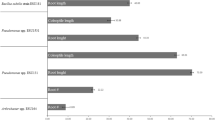Abstract
Occurrence of Azospirillum was investigated in coconut-based farming systems, such as high-density multispecies cropping (15 crops), multi-storeyed cropping (3 crops), mixed cropping with tea and coffee (2 crops), intercropping with tropical tubers (5 crops), mixed farming with grasses (3 crops) and in 3 crops, arecanut,Mimosa invisa and sugarcane from other plots. A total of 26 plantation crops and intercrops were included in the study. Incidence of Azospirillum was determined by 2,3,5-triphenyl-tetrazolium chloride reduction and by culturing root fragments in N-free semisolid malate medium. Root samples from guava, mango and mimosa did not show any tetrazolium reduction or sub-surface pellicular growth. The extent of occurrence of Azospirillum seemed to depend upon the crop combinations. In a mixed farming system where guinea grass was one of the component crops, more root fragments of coconut and pepper demonstrated tetrazolium reduction activity than when guinea grass was absent.Azospirillum lipoferum andA. brasilense constituted 42% and 45% of the isolates, respectively, in the coconut-based cropping systems. Isolates from guinea grass, sugarcane and jackfruit exhibited higher nitrogenase (C2H2 reduction) than those isolated from plantation crops, tuber crops and spices. The large variation in the extent of association and nitrogenase activity of isolates from different crops indicated the need for inoculation with efficient cultures in a number of crops in coconut-based cropping systems.
Similar content being viewed by others
References
Albert S L, Okon Y and Burris R H 1978 Effect of light and temperature on association betweenZea mays andSpirillum lipoferum. Plant Physiol. 60, 528–531.
Barber L F, Russel S A and Evans H J 1979 Inoculation of millet withAzospirillum. Plant and Soil 52, 49–57.
Berg R H, Tyler M E, Novick N J, Vasil V and Vasil I K 1980 Biology ofAzospirillum—Sugarcane association enhancement of nitrogenase activity. Appl. Environ. Microbiol. 39, 642–649.
Boddey R M and Döbereiner J 1984 Nitrogen fixation associated with grasses and cereals.In Current Developments in Biological Nitrogen Fixation. Ed. N S Subba Rao. p. 277–313. Oxford and IBH Publishing Co., New Delhi.
Bouton J H and Zuberer D A 1979 Response ofPanicum maximum Jacq. to inoculation withAzospirillum brasilense. Plant and Soil 52, 585–590.
Central Plantation Crops Research Institute (CPCRI) 1985 Annual Report 1983, Kasaragod, India.
Cote R 1984 American-type culture collection media handbook. ATCC Maryland, USA p. 98.
Döbereiner J 1983 Ten years ofAzospirillum. Experimentia (Supplement) 48, 9–23.
Döbereiner J and Day J M 1976 Associative symbiosis in tropical grasses. Characterisation of micro-organisms and dinitrogen fixing sites. pp. 513–538.In Proc. 1st Intl. Symp. Nitrogen Fixation. Eds. W E Newton and C J Hymen Wash. State Univ. Press, Pullman.
Döbereiner J, Marriel I E and Nery M 1976 Ecological distribution ofSpirillum lipoferum Beijerinck. Can. J. Microbiol. 22, 1464–1473.
Garcia M U, Hubbel D H and Gaskin M H 1978 Process of infection ofPanicum maximum bySpirillum lipoferum. Ecol. Bull. (Stockholm) 26, 373–379.
Magalhaes F M, Baldani J I, Souto S M, Kuykendal J R and Döbereiner J 1983 A new acid tolerantAzospirillum species. An. Acad. Brasil Cienc. 55, 417–430.
Masterson C L and Murphey P M 1979 Acetylene reduction technique.In Recent Advances in Biological Nitrogen Fixation. Ed. N S Subba Rao. pp. 8–33. Oxford and IBH Publishing Co., New Delhi.
Nair P K R 1979 Intensive Multiple Cropping with Coconut in India: Programmes and Prospects. Verlag Paul Parey, Berlin. p. 147.
Nair S K and Subba Rao N S 1977 Microbiology of root region of coconut and cacao under mixed cropping. Plant and Soil 46, 511–519.
Patriquin D G and Döbereiner J 1978 Light microscopy observations of tetrazolium reducing bacteria in the endorhizosphere of maize and other grasses in Brazil. Can. J. Microbiol. 24, 734–742.
Patriquin D G, Gracioli D A and Ruschel A P 1980 Nitrogenase activity of sugarcane propagated from cuttings in sterile vermiculite. Soil Biol. Biochem. 12, 413–417.
Rao A V and Venkateshwarlu B 1985 Most probable number ofAzospirillum associated with roots of inoculated pearl millets. Plant and Soil 88, 153–158.
Rennie R J and Larson R I 1979 Dimtrogen fixation associated with disomic chromosome substitution lines of spring wheats. Can. J. Bot. 57, 2771–2775.
Subba Rao N S 1983 Nitrogen fixing bacteria associated with plantation and orchard plants. Can. J. Microbiol. 29, 863–866.
Tarrand J J, Kreig N R and Döbereiner J 1978, A taxonomic study of theSpirillum lipoferum group, with description of a new genusAzospirillum gen. nov. and two species,Azospirillum lipoferum (Beijerinck) combnov. andAzospirillum brasilense sp. nov. Can J. Microbiol. 24, 967–980.
Author information
Authors and Affiliations
Additional information
Contribution No. 613 of Central Plantation Crops Research Institute, Kasaragod.
Rights and permissions
About this article
Cite this article
Ghai, S.K., Thomas, G.V. Occurrence ofAzospirillum spp. in coconut-based farming systems. Plant Soil 114, 235–241 (1989). https://doi.org/10.1007/BF02220803
Received:
Revised:
Issue Date:
DOI: https://doi.org/10.1007/BF02220803




